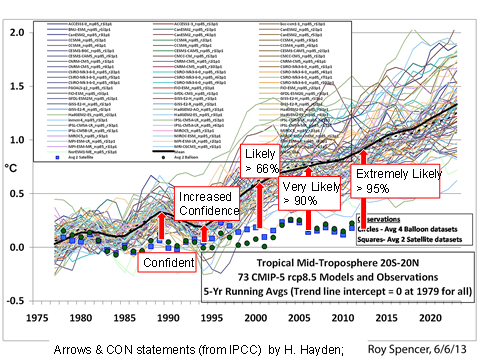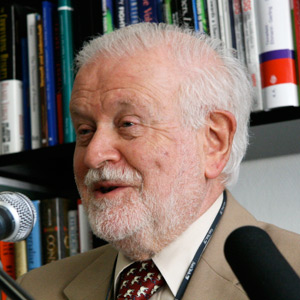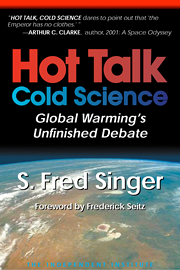The United Nations’ Intergovernmental Panel on Climate Change (IPCC) released a final version of their Summary for Policy Makers (SPM) of its fifth assessment report (AR5) on September 27, 2013. This new SPM reveals that the IPCC has retreated from about a dozen alarmist claims promulgated in its previous reports or by scientists who are prominently associated with the IPCC. Their SPM also contains more than a dozen misleading or untrue statements, plus about another dozen statements that mislead readers or misrepresent important aspects of the science.
Two weeks before the UN-IPCC released its report, an alternative report was released by the Nongovernmental Panel on Climate Change (NIPCC). Unlike the UN-IPCC, NIPCC’s charter is to investigate causes and consequences of climate change from all perspectives rather than just to search for a human impact on climate change. This NIPCC report, titled “Climate Change Reconsidered - II: Physical Science” contradicts many of the IPCC’s findings. It is available online at www.climatechangereconsidered.org
In the discussion that follows, we divide our critique of the IPCC’s SPM into three categories.
1. IPCC-AR5 retreats from previous positions
The IPCC’s 2013 SPM apparently retreats from more alarmist positions struck in earlier assessment reports. For example, the IPCC concedes for the first time that a fifteen-year-long period of insignificant warming (or perhaps even cooling) has occurred since 1998, despite a 7% rise in Carbon Dioxide concentration in the atmosphere. This is striking evidence that there is something wrong with the IPCC’s climate models, which all predict a substantial warming in response to rising CO2.
IPCC scientists are of two minds in trying to explain this discrepancy between models and observations. On the one hand, they argue that this is a statistical fluctuation. One might compare it to fifteen heads in a row when tossing a coin. However, with each passing year without warming, the probability of such a fluctuation becomes smaller.
Other IPCC scientists search for elusive physical evidence for such a lack of warming. One favorite explanation has it that the heat is “hiding in the deep ocean;” but the IPCC fails to explain that heat cannot transfer into the deep ocean without first passing through the shallow ocean, which has not warmed since 2003. It is ironic that at the same time that predictions from 72(!) climate models and observations (from satellites and balloons) increasingly diverge, successive IPCC reports have expressed increasing certainty about human Influences on warming. This disconnect is illustrated in the graph below, prepared by John Christy and Roy Spencer, and further annotated by Howard Hayden.

In spite of the SPMs’ assertion of increasing certainty about dangerous human-caused warming, the IPCC report itself expresses less certainty. For example, AR4 [2007] predicts a temperature rise of between 2 degrees and 4.5 deg C for a doubling of CO2, while AR5 [2013] expands the interval to 1.5 to 4.5 degrees C. These limits happen to be the same ones published in the ‘Charney’ climate report of 1979. In other words, no refinement has been made in 34 years in determining how much warming is likely to result from a doubling of CO2—in spite of much effort and great expenditures of money in model construction.
Another interesting admission: The IPCC now has “low confidence” in predicting more frequent or more extreme droughts and tropical cyclones. Thus, IPCC is specifically revoking its previous more alarmist claims.
2. Misleading or untrue statements
Among the many untrue claims, is one that asserts that post-1950 warming is “unprecedented.” However, as shown by the Hadley [UK] record, it is reported as of about the same magnitude and rate as the 1910–1940 warming.
The IPCC-SPM also suggests a significant radiative forcing for carbon monoxide; but this is contradicted by statements made by the IPCC authors themselves. Carbon monoxide, CO, is not a greenhouse gas.
Elsewhere, the SPM admits that both the sign and amplitude of cloud feedback are uncertain. But then it is impossible to be sure, as claimed, that the net radiative feedback is positive.
In comparing models and observations, the underlying claim is that the models include all of the relevant physics. This is a false statement because our knowledge is far from complete—and specifically, the models omit important forcings, such as changes in ocean currents or solar magnetic activity.
The SPM claims sure evidence for human-caused sea level rise. But there is no observational evidence for the IPCC claim. Sea level has been rising since long before the human era, and generally at much higher rates than observed in the industrial-human period.
3. Deceptive language that misrepresent the Science
The SPM claims that globally averaged surface temperatures show a linear warming trend over the period 1880 to 2012. This is a cherry-picked interval, used to give a false impression of a steady, continuous warming. It includes the major warming between 1910 and 1940, and a slight cooling from 1940 to 1975. It includes also the 1998 warming spike caused by a Super El Nino and temperature ‘jumps’ around 1976 and 2002, which cannot be attributed to human influences. It fails to distinguish fully between temperature ‘trend’ and temperature ’level.’
The SPM misleadingly claims that the troposphere has warmed globally since the mid-20th century. This statement fails to acknowledge that there has been effectively no warming in the tropical troposphere as universally projected by models (the ‘missing hotspot’)
The SPM points out that the maximum global mean sea level during the last interglacial period was at least five meters higher than the present level, but to compare sea levels in the Eemian and the Holocene is misleading since Earth’s orbital configurations with respect to the Sun were different.
Advice for policy makers
Between 1988 and 2007, the span of preparation of its first four assessment reports, the UN’s IPCC was the sole international body able to provide advice to governments on the global warming issue. Since 2008, with the formation of the Nongovernmental Panel on Climate Change (NIPCC), a second and independent team of scientific assessors has emerged.
Now, with the release of the 2013 reports by both the IPCC and NIPCC, due diligence analysis is finally possible. After 2013, any responsible policy maker has an obligation to be fully familiar with the arguments adduced by two teams of climate advisors, who use the same peer-reviewed science but reach quite different conclusions.
The IPCC’s scientific advice can now be weighed against an independent team of scholars. With the same set of peer-reviewed journals for review, the IPCC and NIPCC have come to diametrically opposing conclusions. IPCC scientists remain alarmist about the threat of human-caused global warming. Even while they admit that observations increasingly invalidate their model-based predictions, they are reluctant to acknowledge past errors and new research that challenge their hypothesis of human-caused dangerous climate change.
In stark contrast, NIPCC scientists find no hard evidence for a dangerous warming. They find that the null hypothesis—that observed changes in climate are due to natural causes only—cannot be rejected. NIPCC scientists remain open to new discoveries and further debate.
Towards this end, we present the primary conclusions of NIPCC’s latest report—as they are stated in its SPM:
1. We conclude that neither the rate nor the magnitude of the reported late 20th century surface warming (1979 to 2000) lies outside normal natural variability, nor is it in any way unusual compared to earlier episodes in Earth’s history. Furthermore, solar forcing of temperature change is more important than currently recognized, and evidence is lacking that a 2-degree C rise in temperature (from whatever cause) would be globally harmful.
2. We conclude that no unambiguous evidence exists for adverse changes to the global environment caused by human-related CO2 emission. In particular, the cryosphere is not melting at an enhanced rate, sea-level rise is not accelerating, and no systematic changes have been documented in evaporation or rainfall or in the magnitude or intensity of extreme meteorological events. An increased release of methane into the atmosphere from permafrost or sub-seabed gas hydrates is unlikely.
3. We conclude that the current generation of global climate models is unable to make accurate projections of climate even 10 years ahead—let alone the 100-year period that has been adopted by policy planners. The output of such models should therefore not be used to guide public-policy formulation until they have been validated and shown to have predictive value.have been validated and shown to have predictive value.
***************************************
This essay is based on a Policy Brief published by NIPCC in October 2013, entitled “Scientific Critique of IPCC’s 2013 ‘Summary for Policymakers,’ by Craig D. Idso, Robert M. Carter, S. Fred Singer, and Willie Soon.” It can be accessed at http://heartland.org/sites/default/files/critique_of_ipcc_spm.pdf









